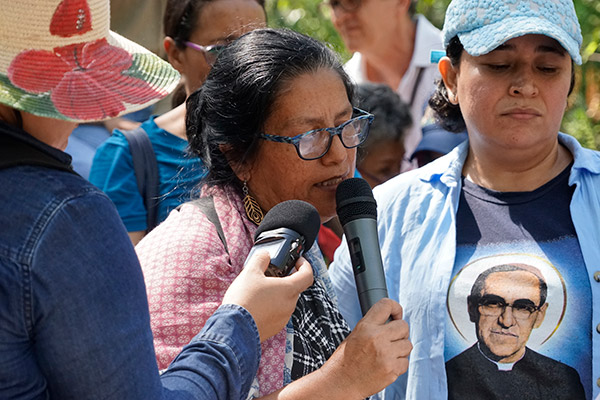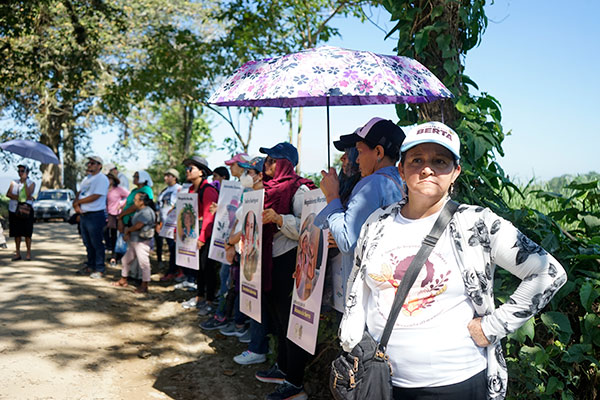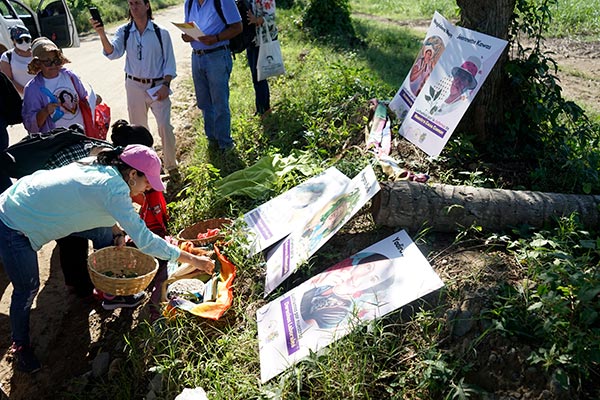Subtotal: $
Checkout-

Visions of the Kingdom
-

Foolhardy Wisdom
-

Tough Love on the Mount
-

Walls behind Bars
-

My Mind, My Enemy
-

Demining the Sahara
-

Just Doing What Christians Do
-

Hating Sinners
-

Students Brave the Heat
-

The Witching Hour
-

Enemy Lovers
-

How God Sees Us
-

Macedonia Morning
-

Tim Keller: New York’s Pastor
-

What Is Time For?
-

Poem: “South Head, a Wild Surmise”
-

Poem: “Lammergeier”
-

Poem: “World Within”
-

When Love Seems Impossible
-

Places to Think with Neighbors
-

Letters from Readers
-

Covering the Cover: The Enemy
-

Thanksgiving Starts in September
-

The Monsignor versus the Fascists
-

Do Activists Need Enemies?

The Making of Martyrs
Recent assassinations of women leading environmental and land reform movements in Honduras have galvanized a people with a long history of martyrdom.
By Robert Donnelly
August 18, 2023
Next Article:
Explore Other Articles:
I’m in Honduran cane country. To the north and south, a sea of freshly planted stalks stretches to the horizon. To the east, the verdant slopes of the Mico Quemado mountains burst through a cloudless, gauzy haze. It’s sweltering at just past eight on a March morning; the buzzing of cicadas augurs an even more intense midday.
Some fifty people are gathered on this fifth Friday of Lent, 2023, at an otherwise nondescript dirt turnoff five miles south of the city of El Progreso. Led by local Jesuits, they will walk a modern take on the Stations of the Cross, to commemorate Catholic martyrs such as Rutilio Grande, a Salvadoran priest murdered in 1977, and Jerome Cypher, a Franciscan killed in Honduras in 1975. They will remember other men: land activists, political dissidents, and, despite this being a religious ceremony, a few guerrillas, their faces on placards and banners as the crowd begins to form.
The walk will also honor women martyrs. Local admirers have created a folk shrine that is the first stop of about half a dozen. It’s dedicated to five women: Berta Cáceres, an environmental activist and vice-presidential candidate assassinated in 2016; Jeannette Kawas, a marine and wildlife protector shot to death for her activism; Margarita Murillo, a campesino rights advocate also shot to death; Magdalena Morales, an Afro-Honduran who headed the country’s largest peasants’ union; and Yadira Rodríguez, a labor activist for factory workers. The organizers refer to all five as martyrs, although Morales and Rodríguez died of natural causes. Today’s crowd is mainly female, so there may well be a deeper sense of identification with these heroes, who were mothers, daughters, and, in the case of Cáceres, a grandmother – and because of the recency of their deaths, all occurring from 1995 to 2020. Taking the microphone, Sister Rosa María Trochez describes the station as “an altar of many colors, of many hopes.”

A woman speaks during the Stations of the Cross walk honoring martyrs, land activists, and political dissidents near El Progreso, Honduras. All photographs by Joksan Flores.
The altar, such as it is, is set on a patch of grass upon which people are placing posters – some elegiac, some bold, some whimsical. Next to them shawls of different colors and patterns lie alongside bowls of red, black, and white beans – symbols of diversity and solidarity. There’s some ritual: Sister Rosa María dips a cotton ball in oil and anoints a few foreheads. On the walk from the turnoff, some of the women have been chanting solemn prayers – “Though my faults may be great, greater is your goodness” – and swaying to the meditative rhythm.
A woman introduces herself to me. Suyapa has a coppery complexion that matches the hair she wears under a ballcap emblazoned with “Berta.” She has a purple velvet dress and a floppy homemade poster with images of four of “our martyrs”: Berta Cáceres, Óscar Romero, Rutilio Grande, and James Guadalupe Carney.
Grande was a priest in rural El Salvador when he was assassinated by paramilitaries in 1977. His death emboldened Archbishop Romero to defy the dictatorship, a decision that cost Romero his own life three years later. The US-born Carney, a Jesuit, organized agricultural cooperatives and fought for campesino rights in Honduras. He later joined a Che Guevara–inspired guerrilla unit and, in 1983, disappeared under mysterious circumstances.
Suyapa and I look at the tribute to Cáceres. Her poster shows a mischievous smile framed by her trademark curly hair. People are now chanting in full voice, “Berta no se murió / Se creó millones / Todos somos Berta,” or “Berta didn’t die / She created millions [of followers] / We are all Berta.”
Cáceres was killed in March 2016, just days before her forty-fifth birthday, when hitmen burst into her home in the city of La Esperanza on orders from a hydroelectric dam contractor and shot her to death. A veteran campaigner, she had been fighting the Agua Zarca dam on the Gualcarque River of western Honduras for three years. Cáceres believed the dam would profane the environment, which, she argued, the local Lenca people considered sacred. She also challenged the manner in which the contractor, a company called Desa, had gone about obtaining consent for the project in local communities. In retaliation, a Desa executive and former Honduran military intelligence officer named Roberto David Castillo Mejía plotted to kill her. Six years later, Castillo Mejía was convicted of masterminding the crime, but only after significant international pressure, including a letter urging his prosecution from sixty-one EU parliamentary members. In the end, the dam was never built, and the project’s financial backers withdrew support after Cáceres’s death.
Her loss is still felt among progressive social movements. “There is nobody in Honduras like Berta Cáceres: her ability to move from Washington to the poorest communities in Honduras.… She has not been replaced,” says Karen Spring, who is with the Honduras Solidarity Network based in Tegucigalpa. Despite her absence, though, Cáceres’s legacy is still strong. Her face – sometimes with an inviting smile, other times more resolute – adorns urban walls and features prominently in the progressive media.
The legacy of another of the martyred women has a harsher edge. At least that’s my impression when Suyapa points me to this first station’s tribute to Margarita Murillo, a land activist and peasant organizer killed in 2014. It shows a mestiza speaking into a microphone against a backdrop of cornstalks. “She was killed, shot in the back while plowing her field,” Suyapa says, an indignant look crossing her face.
A founding member of Honduras’s largest campesino trade union, Murillo, 56, was a long-time land activist on the northern coast. Immediately prior to her death, she had spearheaded a campaign to title a large parcel of land for a farm cooperative. Many suspect that’s the reason killers wearing ski masks descended on her as she tended a small garden near her home in the city of Villanueva.
Like Cáceres, Murillo also withstood years of threats, including the kidnapping of a son and the nonfatal shooting of her husband. Her toughness, I think, explains Murillo’s appeal, given the way “shot in the back” seems to steel Suyapa. For another woman, it’s Murillo’s “spirit of resistance” that especially inspires her work as a human rights activist.
The crowd is still singing “We are all Berta” when a young woman strums the opening chords to Chilean folksinger Violeta Parra’s “Gracias a la vida.” The two songs intermingle as children dig into tamales wrapped in banana leaves, their parents, some with umbrellas open for the sun, chatting with old friends. Flourishing tropical trees – ceiba, acacia, red cedar, and mahogany – mark the path to the next station and belie the name of the community, Arena Blanca, or “white sand.” Scattered one-room shacks improvised from corrugated tin, warped clapboard, and cement dot the scenery. I wave toward one, and a smiling woman reciprocates with a palm frond she’s using to fan kindling, on her back a baby asleep in a sling.
I’ve attended liberationist church services before. I remember getting swept up in the feeling of solidarity, talismanic energy radiating from portraits of icons surfing the crowd. Here in Arena Blanca, the legacies of women like Murillo and Cáceres resonate more than if only purely religious figures were being celebrated, while the religious imagery and language of martyrdom and sacrifice transcend secular politics.
The deaths of Cáceres and Murillo are only a fraction of the politically motivated killings Honduras has witnessed since the coup in 2009, when a right-wing legislative putsch forced President Manuel Zelaya into exile and laid the foundation for a dozen years of crony-capitalist rule. In its immediate aftermath, state-sponsored repression increased, and “disproportionate use of force” by the police and military resulted in the deaths of protesters. But much blood was also shed away from these demonstrations, as long-standing conflicts over land and natural resources came to a head in the countryside.
The largest concentration of these killings occurred in a rich agricultural region called the Lower Aguán River Valley. Considered ideal for growing African palm, whose oil is used in processed foods and biofuel, the Bajo Aguán’s coveted bottomland has long pitted agribusinesses against peasant cooperatives. But the risk of violence sharpened quickly after 2009. Over the next three years, ninety-three peasant farmers and supporters were killed in the region. Annie Bird, a human rights researcher who documented these killings, also found strong evidence to suggest the involvement of soldiers.

The crowd stops at a station during a Stations of the Cross walk near El Progreso, Honduras.
The immediate causes of the violence varied across the region. In one disputed area, the killing of an important mediator served as the flashpoint; in another, goading by a government bureaucrat precipitated a deadly land seizure; in still another, indignation over forced evictions prompted campesinos to retaliate. But the overarching pattern of conflict was similar. Emboldened by the coup and earlier neoliberal schemes, private capital intensified claims on lands that peasants asserted belonged to them or had been designated for redistribution to them. The use of legal chicanery and, in many cases, outright fraud characterized the privatization efforts. In retaliation, peasant groups engaged in land “recovery” actions, though doing so escalated the risk of confrontation with heavily armed agribusiness security forces.
A few days before the Lenten Station of the Cross event I had traveled to the Bajo Aguán. The night of the trip, my taxi driver in La Ceiba, a port city on the northern coast, advised against it. “They’ve got campesinos fighting with AKs and the narco!” I countered that the worst violence had already taken place, and that maybe he was misled by the sensationalistic local newspaper I saw crumpled on the floor. The next morning, ignoring his advice, I hopped an early bus to Tocoa, a regional hub.
My driver’s concerns weren’t completely misplaced: In the first five months of 2023, eight environmental and land defenders were murdered in the region, compared with just six such killings nationwide in 2022, according to the UN High Commissioner for Human Rights. And there are other conflicts here; besides the fight over African palm, there are deadly disputes over beachfront development, as well as over mining and other “extractive” industries.
One of the communities that has seen some of the bloodshed is a tiny place called Guadalupe Carney. Named after the controversial priest, it’s not even a speck on the map along CA13, the highway stretching from Puerto Castilla through the Bajo Aguán to La Ceiba and points west.
To get there I take a morning bus from Tocoa. On board, a soothsayer with a disfigured arm walks the aisle, collecting alms in exchange for short prayers and the laying on of hands. Out the window the palm stands, in different stages of maturation, come right up to the highway; the plantations’ uniformity standardizes the landscape. A thick canopy covers the ground in shadow, in contrast to the brightness of late morning. Trucks crammed with huge crimson-speckled mounds of palm fruit head for the mill, where the precious oil will be squeezed out. Workmen in garb resembling beekeepers’ wield long scythes, cutting down the fruit where it bunches heavily under the fronds.
It’s hot and dusty when I meet Adolfo Cruz outside the Guadalupe Carney general store, which he locks up before agreeing to show me around. Cruz seems reluctant at first, and I notice midway up the town’s main road that he’s on the phone and mildly assuaging the other person’s concerns: journalist, wants to take some photos. He gives the other caller the name of this magazine, which I realize too late has a decidedly agrarista ring to it, and I’m uncertain whether this will play in my favor, given the vagaries of the land conflict. But it looks like I check out, and he hangs up the phone.
Cruz is about five-foot-six and stout, wearing work pants and a dirt-creased T-shirt. He tells me he’s one of the founders of the community, which dates to May 2000, when hundreds of refugees from the northern coast resettled here in the wake of Hurricane Mitch. The community now numbers about two thousand, its land comprising the village and surrounding family-parceled farmland. As throughout the region, African palm reigns supreme, partly due to the soil and weather but also because the government won’t back credit to plant other crops.
In the post-coup tumult, Guadalupe Carney was one of many battlefields of the Bajo Aguán land conflict. The village’s bloodiest day was November 15, 2010, when five men were killed by corporate security personnel after attempting to breach a large plantation called El Tumbador. The villagers believed the land was government property and designated for land redistribution. Moreover, they claimed a government official had encouraged them to occupy the plantation – a necessary first step for making any future legal claim. For its part the company argued it had purchased the land in 1992, during a short-term privatization window.
Pedro Ulloa, a local human rights lawyer and small farmer, told me the group that conducted the “recovery” action at El Tumbador had no weapons and posed no threat to the security guards who were on shift that morning. Yet the group quickly found itself surrounded not just by the guards but also by other armed men wearing street clothes. Ulloa maintains that these other men were from a local army garrison, judging by an M-60 machine gun and multiple M-16 rifles they carried.
When the shooting started, most of the peasants fled into nearby hills. But the five mortal casualties lay on the ground for four to five hours, Ulloa said, before relatives and friends could safely recover the bodies. “Cartridges were scattered on the ground like frijoles,” he said. Yet despite so much evidence and the presence of many witnesses, neither national nor local authorities have conducted a proper investigation. “We’ve done everything possible to get them to investigate what happened, but the authorities haven’t done anything,” Ulloa said.
Now, at the Stations of the Cross walk, I’m thinking about the conflict in the Bajo Aguán, with deaths on both sides, however disproportionate, that can’t easily be morally justified. I notice that none of this moral complexity comes to expression in the narratives the speakers have so far presented of “our martyrs.”
A young man and woman unfurl a vinyl banner in red and black with four campesino faces boldly gazing from it. These are “los mártires del Jute,” a small band of peasant farmers turned guerrillas from the mountains north of El Progreso. In 1965, they were wiped out after a “campesino traitor” tipped off soldiers who subsequently ambushed them at a local ranch. Seven men were killed, ending the insurrectionary threat the group might have posed and passing them into folklore. There’s a popular song about them that closes with, “the martyrs who died, died for the revolution,” and it’s played here at the walk.
The men had initially taken up arms in self-defense in the repressive wake of a military coup in 1963. But by the following year the group had “transformed itself into a guerrilla unit with offensive purposes” comprising “twenty-two well-armed men.”
To me, celebrating armed combatants as religious martyrs in a Stations of the Cross walk would seem theologically tenuous at best. I try broaching the issue with the local Jesuits, the walk’s lead organizers, but they don’t seem too interested in discussing it. The inclusion of these guerrillas clearly does animate the crowd, some of whom are singing corridos in their honor. I can see how the bold faces on the banner could galvanize those who identify with the campesinos over the rich landowners – a feudal struggle that’s still salient. And the biographies of the guerrillas themselves put flesh on the larger political struggle, delivering it from abstraction.

Participants pay tribute to martyrs during a Stations of the Cross walk near El Progreso, Honduras.
But should they be classed as martyrs even after a bright line has been crossed and arms taken up? The young woman holding up the banner, Mercy Ayala Claros, a human rights researcher, also deflects my question. She says she considers events like today’s a bridge linking her generation to the campaigns of the sixties and seventies. “As young people, we have this enormous challenge: keeping alive historical memory so that we can connect with the past.”
Further blurring any such line, the idea of martyrdom in a secular sense is widely used for mobilizing effect in Honduran politics. At her inauguration in January 2022, leftist president Xiomara Castro invoked the “martyrs” of the anti-coup resistance movement. State-run news media have designated as “martyrs” the victims of repression. At the unveiling of a plaza to honor Isy Obed, a teenager shot in the head at a political demonstration in 2009, a journalist referred to “an important inauguration in memory of those martyrs who died.”
We’re now approaching the last station of the walk. It honors James Guadalupe Carney, the controversial Jesuit and self-described “guerrilla fighter” who went missing in Honduras in 1983 and now has a town named after him. A poster shows a bespectacled, dark-haired man deep in thought. On the trunk of a nearby ceiba his epitaph, “I fell in love with the Honduran peasantry,” is painted in Spanish. This is the most tranquil of the stations. A copse of leafy trees rings a small swimming hole, while the mountain brook that feeds it burbles downstream.
While the speaker lionizes Carney and tells the legend of his death, people dip their feet in the brook. Afterward, there is a Mass, and one of the celebrants urges us to be more like Father Carney: a prophet, a rebel, a campesino. Then, after a simple lunch – red beans, cotija cheese, tortillas, and coffee – we pile into Suyapa’s truck.
As we drive down the dirt road we’ve just walked up, the announcer on Radio Progreso is reminding his listeners that it is an important feast day. Today, March 24, 2023, marks the forty-third anniversary of the death of Saint Óscar Romero. We listen as the radio broadcasts Romero’s last public homily, in which he urges soldiers of the regime to refuse immoral orders:
I would like to make an appeal especially to the men of the army, and concretely to the National Guard, the police, and the troops. Brothers, you are a part of our own people. You are killing your own brother and sister campesinos, and against any order a man may give to kill, God’s law must prevail: “You shall not kill!”
The next day an assassin shot Romero as he said Mass at a chapel in San Salvador. Romero wasn’t outspoken when he became archbishop in 1977, but the rise of death squad terrorism throughout the country saw him emerge as the regime’s most powerful critic. And in early 1980, amid mounting death threats, he foreshadowed his assassination with a prophecy:
I need to say that as a Christian I do not believe in death without resurrection. If they kill me, I will rise again in the people of El Salvador.… A bishop may die, but the church of God, which is in the people, will never die.
Romero’s prophecy echoes today, in this impoverished corner of north-central Honduras. At the walk, many are wearing T-shirts or carrying framed portraits of the bespectacled and beatific Saint Óscar. One of Suyapa’s passengers reminds us that, though today marks Romero’s killing, it also celebrates his resurrection “in the people.”
In a sense, this is so. Scholars have shown how the outrage over Romero’s assassination bolstered the anti-regime movement in El Salvador and around the world. And his legacy and likeness remain important rallying symbols for progressive causes, ranging from rights-based immigration reform to greater public oversight of US military operations.
It’s no secret that martyr stories easily become hagiographic, presenting a simplified and dramatized narrative to impassion and embolden followers. On an audio recording of his assassination, Romero is mid-homily when a single gunshot interrupts him; the 1989 film Romero has him shot while raising the chalice, his blood mingling with the consecrated wine. Suyapa’s telling of Murillo’s story – “She was shot in the back while plowing her field” – conjures the cowardly villain so cogently. I later discover that this detail is absent from an Amnesty International statement, which suggests Murillo received only frontal wounds. Yet it’s hard to imagine such a vivid detail being redacted from the popular account, nor does it seem to matter here. It powerfully presents the evil of the other side and, judging by the way it animates the people at the walk, it inspires action too.
I’m pondering this when a photo on social media catches my eye. It’s posted by a journalist who worked in El Salvador in the 1980s. He and a female colleague are standing with the country’s top death squad leader, Roberto D’Aubuisson, the man who orchestrated the assassination of Archbishop Romero. D’Aubuisson looks noticeably shorter than the two US journalists and is too skinny and unimposing to fit my mental image of Blowtorch Bob, his nickname and preferred torture implement. He’s smiling and looks more mestizo than the ostentatious French surname would suggest. It’s no stereotypical villain’s face, and so instead of demonizing him, I’m left wondering what made him who he became: What was the concatenating event or decisive factor? Could knowing that help explain his actions and somehow keep others from repeating them? Or would only the naive ask such questions?
Clearly, every martyr needs a villain: Romero his D’Aubuisson, Cáceres her Castillo Mejía, George Floyd his Derek Chauvin. Aren’t these enemies somehow indispensable, their sin, like Judas’ kiss, essential for a greater resurrection?
It’s that living hope of resurrection I’m left with as I leave behind the cane fields and the cicadas and the reinvigorated activists willing to put their own lives on the line. In a land of many martyrs, those who have died have not died in vain. There may not be a million Bertas, but there are many.
Already a subscriber? Sign in
Try 3 months of unlimited access. Start your FREE TRIAL today. Cancel anytime.




































Thomas Harmon
Donnelly has done a beautiful job here, taking us deep into Honduras and even deeper into the moral issues raised by violent resistance to violent oppression. Because of his ability to bring the Honduran campesinos to life for me, I am left feeling that they have every right to call their fallen brothers and sisters "martyrs." I appreciate the hopefulness he expresses at the conclusion of the article. Oscar Romero was right: Martyrs do not die in vain.
burl self
American trained officer corps at Ft Moore School of the Americas.